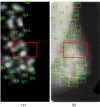Computer-aided detection of architectural distortion in prior mammograms of interval cancer
- PMID: 20127270
- PMCID: PMC3046672
- DOI: 10.1007/s10278-009-9257-x
Computer-aided detection of architectural distortion in prior mammograms of interval cancer
Abstract
Architectural distortion is an important sign of breast cancer, but because of its subtlety, it is a common cause of false-negative findings on screening mammograms. This paper presents methods for the detection of architectural distortion in mammograms of interval cancer cases taken prior to the detection of breast cancer using Gabor filters, phase portrait analysis, fractal analysis, and texture analysis. The methods were used to detect initial candidates for sites of architectural distortion in prior mammograms of interval cancer and also normal control cases. A total of 4,224 regions of interest (ROIs) were automatically obtained from 106 prior mammograms of 56 interval cancer cases, including 301 ROIs related to architectural distortion, and from 52 prior mammograms of 13 normal cases. For each ROI, the fractal dimension and Haralick's texture features were computed. Feature selection was performed separately using stepwise logistic regression and stepwise regression. The best results achieved, in terms of the area under the receiver operating characteristics curve, with the features selected by stepwise logistic regression are 0.76 with the Bayesian classifier, 0.73 with Fisher linear discriminant analysis, 0.77 with an artificial neural network based on radial basis functions, and 0.77 with a support vector machine. Analysis of the performance of the methods with free-response receiver operating characteristics indicated a sensitivity of 0.80 at 7.6 false positives per image. The methods have good potential in detecting architectural distortion in mammograms of interval cancer cases.
Figures







Similar articles
-
Measures of divergence of oriented patterns for the detection of architectural distortion in prior mammograms.Int J Comput Assist Radiol Surg. 2013 Jul;8(4):527-45. doi: 10.1007/s11548-012-0793-3. Epub 2012 Sep 30. Int J Comput Assist Radiol Surg. 2013. PMID: 23054747
-
Detection of architectural distortion in prior mammograms of interval-cancer cases with neural networks.Annu Int Conf IEEE Eng Med Biol Soc. 2009;2009:6667-70. doi: 10.1109/IEMBS.2009.5334517. Annu Int Conf IEEE Eng Med Biol Soc. 2009. PMID: 19964909
-
Detection of architectural distortion in prior mammograms.IEEE Trans Med Imaging. 2011 Feb;30(2):279-94. doi: 10.1109/TMI.2010.2076828. Epub 2010 Sep 16. IEEE Trans Med Imaging. 2011. PMID: 20851789
-
Measures of angular spread and entropy for the detection of architectural distortion in prior mammograms.Int J Comput Assist Radiol Surg. 2013 Jan;8(1):121-34. doi: 10.1007/s11548-012-0681-x. Epub 2012 Mar 30. Int J Comput Assist Radiol Surg. 2013. PMID: 22460365
-
Methods Used in Computer-Aided Diagnosis for Breast Cancer Detection Using Mammograms: A Review.J Healthc Eng. 2020 Mar 12;2020:9162464. doi: 10.1155/2020/9162464. eCollection 2020. J Healthc Eng. 2020. PMID: 32300474 Free PMC article. Review.
Cited by
-
Bilateral Image Subtraction and Multivariate Models for the Automated Triaging of Screening Mammograms.Biomed Res Int. 2015;2015:231656. doi: 10.1155/2015/231656. Epub 2015 Jul 9. Biomed Res Int. 2015. PMID: 26240818 Free PMC article.
-
Supervised Learning Occurs in Visual Perceptual Learning of Complex Natural Images.Curr Biol. 2020 Aug 3;30(15):2995-3000.e3. doi: 10.1016/j.cub.2020.05.050. Epub 2020 Jun 4. Curr Biol. 2020. PMID: 32502415 Free PMC article.
-
A Novel Fusion-Based Texture Descriptor to Improve the Detection of Architectural Distortion in Digital Mammography.J Digit Imaging. 2021 Feb;34(1):36-52. doi: 10.1007/s10278-020-00391-5. Epub 2020 Nov 11. J Digit Imaging. 2021. PMID: 33179194 Free PMC article.
-
The diagnostic value of MRI for architectural distortion categorized as BI-RADS category 3-4 by mammography.Gland Surg. 2020 Aug;9(4):1008-1018. doi: 10.21037/gs-20-505. Gland Surg. 2020. PMID: 32953609 Free PMC article.
-
Measures of divergence of oriented patterns for the detection of architectural distortion in prior mammograms.Int J Comput Assist Radiol Surg. 2013 Jul;8(4):527-45. doi: 10.1007/s11548-012-0793-3. Epub 2012 Sep 30. Int J Comput Assist Radiol Surg. 2013. PMID: 23054747
References
-
- Blanks RG, Wallis MG, Moss SM. A comparison of cancer detection rates achieved by breast cancer screening programmes by number of readers, for one and two view mammography: Results from the UK National Health Service Breast Screening Programme. J Med Screen. 1998;5(4):195–201. - PubMed
-
- Homer MJ. Mammographic Interpretation: A Practical Approach. 2. New York: McGraw-Hill; 1997.
Publication types
MeSH terms
LinkOut - more resources
Full Text Sources
Medical

